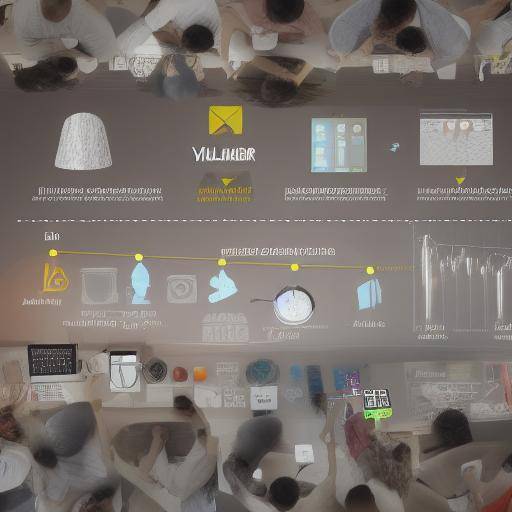
Introduction
Have you ever felt lost on the way to your goals? Establish goals is an essential tool to direct our lives, both professionally and personally. Without clear and well-defined goals, it is easy to deviate and lose sight of what we really want to achieve. This article will guide you through the process of establishing effective goals, offering practical advice, detailed analysis and real examples that will help you achieve your dreams systematically and efficiently.
In this article, you will learn about the importance of setting goals and how to do so in order to increase your chances of success. We will analyze the differences between goals and objectives, how to determine whether your goals are realistic, and how to keep your motivation along the way. In addition, we will explore best practices and methods for achievement of targets.
Follow us on this extensive and detailed guide that not only seeks to inform, but also to inspire and equip you with the tools necessary to transform your desires into realities.
History and Background
Origins of the Metas Establishment
The concept of setting goals has its roots in psychological theory and business practices. Since ancient times, the human being has set goals to survive and prosper, but it was in the twentieth century when this concept began to be studied scientifically.
One of the first formal approaches to setting goals comes from the psychologist Edwin Locke, whose work in the 1960s laid the foundations for what we now know as the theory of setting goals. Locke discovered that people do better when they have specific and challenging goals. This theory has been confirmed and expanded in many studies, becoming a cornerstone in business management and motivational psychology.
Evolution and Development
The development of the theory of setting goals has gone a long way. Since its formulation by Edwin Locke, there have been numerous studies and research that have refined our understanding of how and why the goals work. One of the important milestones was the introduction of the SMART concept by George T. Doran in 1981. SMART is an acronym that refers to specific goals (Specific), Medibles (Measurable), Alcanzables (Achievable), Relevantes (Relevant) and Temporales (Time-bound).
Another important aspect of the development of this concept has been the incorporation of targets in the context of business management. Peter Drucker, a renowned management theorist, popularized the idea of goal management (Management by Objectives, MBO) in the 1950s, which integrated the establishment of goals as a central part of organizational success.
Case Study: Toyota and the Miracle of Metas
A clear example of achievement of targets at the organizational level is Toyota. The Japanese company is globally known for its efficient production system and its continuous improvement culture. A key component of its success has been the ability to establish clear and continuous goals through the Kaizen method. Kaizen, which means continuous improvement, implies that all employees, from the CEO to the operators, set small but attainable goals every day. This approach has allowed Toyota to stay at the forefront of the automotive industry for decades.
Analysis in Deep
Benefits of Setting Targets
Establish goals offers many benefits. Here are some of the highlights:
- Clarity and Approach: Having clear goals helps you focus your energy and resources on what really matters.
- Motivation: Well-defined targets act as a constant source of motivation, pushing you forward even when you face obstacles.
- Progress measurement: The goals allow continuous monitoring of progress, facilitating the necessary adjustments on the way.
- Efficiency: By knowing exactly what you want to achieve, you can use your resources more efficiently.
- Personal satisfaction: Reaching your goals provides a sense of achievement and personal elevation.
Common Challenges and How to Overtake
Despite the benefits, establishing and achieving goals comes with its own set of challenges. Some of the most common include:
- Procrastination: It is easy to fall into the temptation to leave things for later. Combating procrastination involves dividing large goals into smaller and manageable tasks.
- Lack of Realism: Establishing unreachable goals can be discouraging. Make sure your goals are attainable within your capabilities and resources.
- Lack of Long-Term Motivation: Maintaining motivation can be difficult for long periods. To overcome this, celebrate your minor achievements on the way to the ultimate goal.
Corto vs. Long term
Short-term targets They are usually projects or tasks that you can complete in a shorter period of time, usually less than a year. These goals are crucial to providing a sense of progress and immediate achievement. Examples include learning a specific skill, completing a short course or reaching a monthly financial goal.
Long-term targets are goals that can take several years to reach. These require more extensive planning and sustained engagement. Typical examples include obtaining a university degree, reaching a particular position in your career, or preparing for retirement.
Both types of goals are important and must coexist in your life plan. Short-term goals act as steps towards your long-term goals, making them more manageable and less overwhelming.
Statistics and Relevant Data
According to a study by the University of Scranton, only 8% of people achieve their New Year goals. This highlights the need for effective strategies for the establishment and achievement of targets. In addition, another Harvard Business Review study found that those who write their goals are 42 percent more likely to reach them. These data underline the importance of structured methods to achieve the desired success.
Full review
Practical Applications
Target-setting techniques are not only applied individually, but also in organizational and community contexts. For example, companies use company-wide objectives to align themselves with their business strategies. The objectives are generally divided into departmental and personal goals, ensuring that every employee is contributing to the achievement of organizational goals.
In education, teachers set specific goals for their students, fostering an environment where continuous learning and personal development are valued. Similarly, non-profit organizations set clear targets to measure their impact on the community and adjust their programmes accordingly.
Best Practices and Approaches
One of the best practices for setting targets is to follow the SMART format:
- Specific: Define clearly what you want to accomplish.
- Measurable: Make sure you can measure your progress.
- Reachable: Sets goals that are realistic and attainable.
- Relevant: Raise your goals with your values and needs.
- Temporary: Sets a deadline for achieving each goal.
Another effective approach is the WOOP method, which means Desire (Wish), Result (Outcome), Obstacle (Obstacle) and Plan (Plan). This method helps you to visualize both the positive results and the obstacles you might encounter, and prepares you to overcome them with a specific plan.
Pros and Contras
While setting goals has many benefits, there are also some negative aspects to consider:
Pros:
- They provide a clear direction and purpose.
- They promote discipline and focus.
- They help measure progress and adjust strategies.
Contracts:
- They can be discouraging if they don't.
- They can cause stress and anxiety if they are not realistic.
- They require constant review and adjustment to stay relevant.
Comparison and Analysis
Comparing Set Metas vs. Effective objectives
Although the terms Targets and Actual objectives They are often used indistinctly, there are subtle but significant differences between them. Targets tend to be broad and long-term, while targets are specific and short-term. For example, a goal could be "to become an expert in digital marketing," while a goal would be to "complete an advanced digital marketing course in six months."
Both are essential, as the objectives are the building blocks that will lead you to your goals. Without concrete goals, your goals may seem unreachable and demotivating.
Examples and Scenarios
- Example 1: If your goal is to run a marathon, your goals might include enrolling in a local 5K race first, then increase your weekly distance gradually, and finally run a half marathon as a pretest.
- Example 2: If your goal is to increase your savings by 20% this year, your goals may include cutting unnecessary expenses, automating your savings, and looking for additional income.
These examples demonstrate how to break down a broad goal in actionable and manageable steps.
Practical and Accessible Tips
Practical Tips for Establishing Effective Targets
**Write your Targets:**Creating a written record increases your chances of success. Keep a goal diary and update it regularly.
**Use the SMART Method:**Apply the format SMART (Specific, Medible, Alcanzables, Relevants, Temporals) to give structure to your goals.
**Visualize Success:**Imagine how your life will be once you achieve your goals. This visualization technique can increase your motivation and focus.
**Divide and Vence:**Divide big goals into smaller and manageable tasks. Set intermediate goals to measure your progress.
**Sets realistic times:**Not all goals are reached overnight. Assist realistic time frames and adjust as necessary.
**Use Resources and Tools:**Use apps and tools like Trello, Google Calendar or any other platform that will help you organize and track your goals.
**Find Feedback:**Share your goals with someone confident and request feedback. This can bring new perspectives and keep you responsible.
**Adapt and Adjustment:**Don't be afraid to adjust your goals if circumstances change. Flexibility is key to staying on the right track.
Step by Step Guide
Step 1: Define Your Main Target
Deeply reflect on what you really want to accomplish. Define your main goal clearly and concisely.
Step 2: Breakdown in Specific Objectives
Decompose your main goal in specific goals that will help you step by step.
Step 3: Apply the SMART Method
Check each target under the method lens SMART and adjust as necessary.
Step 4: Design an Action Plan
Develop a detailed plan that includes daily, weekly or monthly actions.
Step 5: Implement and Monitor
Start working on your goals, keep track of your progress and make adjustments when necessary.
Step 6: Review and Adjust
Review your goals and plan of action periodically to ensure that you are on the right track.
Lists for Greater Clarity
Steps to Split Targets:
- Identify the main goal.
- Divide in achievable sub-metries.
- Attend deadlines to each sub-meta.
- Sets specific actions and deadlines.
Common Errors at the Metas Establishment and How to Avoid them:
- Unclear or vague targets.
- Solution: Use the SMART method to give clarity.
- Don't measure progress.
- Solution: Establishes success indicators and performs periodic evaluations.
- Lack of motivation.
- Solution: Celebrate the small achievements and keep visual reminders of your goals.
- Unrealistic moments.
- Solution: Be realistic with the time and resources available.
Industry Perspectives and Expert Reviews
Industry Insights
In the business world, setting goals has become a fundamental pillar for organizational success. Giants like Google use the OKR (Objectives and Key Results) system to align and track the goals throughout the organization. This methodology not only sets goals, but also defines the key results that indicate success.
Opinions of Experts
Edwin Locke, a pioneer in the theory of setting goals, says: "Specific and challenging goals lead to higher performance compared to easy goals or no goal at all."
Angela Duckworth, author of "Grit: The Power of Passion and Perseverance", argues that the combination of long-term goals and the ability to persevere is what differentiates the winners of others.
Having expert opinions helps to ratify the techniques we discuss and provides a sound theoretical guide to apply in practice.
Emerging trends
Currently, artificial intelligence and data analysis are revolutionizing how organizations establish and achieve goals. Predictive analysis tools allow companies to anticipate challenges and adjust their strategies in real time, thus improving their ability to achieve objectives faster and more accurately.
Case Studies and Real Applications
Case Study: Apple Inc.
Apple is a clear example of a company that effectively uses goals and targets to promote innovation and continuous success. Under the leadership of Steve Jobs, Apple set ambitious and clear goals, such as the iPhone launch, which revolutionized the mobile technology industry. Jobs's focus on perfection and constant innovation demonstrates how the establishment of specific goals can lead a company to an unprecedented level of global success and recognition.
Case Study: Adidas and Sustainability
Adidas has set clear and attainable goals in its commitment to sustainability. The company is committed to using recycled materials throughout its product line by 2024. This objective is specific, measurable, achievable, relevant and temporary (SMART), and reflects the growing trend of companies towards social responsibility and sustainability. By establishing and pursuing this kind of goals, Adidas not only improves their business practices, but also inspires others to follow their example.
Applications in Different Contexts
**Educational context:**In the field of education, teachers and educators can set clear goals for their students, such as improving certain skills or reaching a specific level of competition on a given subject. These goals can be customized according to the individual needs of students and can be measured through periodic evaluations and specific projects.
**Personal context:**On a personal level, setting goals can help individuals improve their overall well-being. For example, someone can set the goal of improving their physical health through a regular exercise regime and a balanced diet. By defining specific, measurable and attainable goals, people are more likely to remain motivated and committed to their well-being.
Future Trends and Predictions
Impact of Technology on Metas Establishment
Technology will continue to play a crucial role in how we set and achieve our goals. Project management goals and platform tracking applications are continually improving, offering users a range of tools to track their progress and stay motivated.
**Example:**Applications such as Asana and Monday.com allow companies and teams to coordinate their efforts around shared goals, facilitating collaboration and monitoring of real-time progress. These tools also offer data analysis that allows organizations to make informed adjustments on the go.
Current Data-Based Predictions
Based on current trends, it is expected that:
- Increased Use of AI and Machine Learning: Artificial intelligence technologies and automatic learning are expected to play an even more significant role in goal tracking, providing predictive insights that can help to adjust strategies more accurately and efficiently.
- Target customization: With the rise of customization in various sectors, the goals will also be more tailored to individual needs. Digital tools will provide customized recommendations based on user behavior and preferences.
- Major Approach in Sustainability and Welfare: At both personal and organizational levels, sustainability and well-being goals will gain even more relevance, reflecting a continuous shift towards more responsible and conscious practices.
Conclusion
Summary of Key Points
Importance of Targets: The establishment of goals is essential for both personal and professional achievements. It gives us direction, focus and motivation.
SMART Method: Defining Specific, Medible, Alcanzables, Relevantes and Temporales goals is a proven strategy to achieve success.
Disaggregate in Objectives: Splitting major goals into more manageable tasks and establishing intermediate milestones is crucial to maintaining motivation and measuring progress.
Tools and Technology: Using digital tools and emerging technologies can significantly improve our ability to follow and achieve our goals.
Information Value Strengthening
Throughout this article, we have explored various strategies and knowledge about how Targets and to achieve Actual objectives more consistently. By implementing these approaches, you can transform your aspirations into tangible achievements, improve your overall well-being and achieve new heights in your personal and professional life.
Call for Action
We encourage you to start today. Take a time to reflect on your goals and apply the principles discussed in this article. Write them, do them SMART, and use the tools available to keep you on the right track. The first step towards your dreams begins with a small act of conscious determination and planning.
Frequently asked questions
What is the SMART method for setting goals?
The SMART method is a strategy to make your memories clearer and more achievable. SMART is an acronym that means:
- Specific (Specific): Targets must be clear and specific, eliminating ambiguity.
- Measurable: They must have measurable success criteria, to know when you've reached your goal.
- Reachable (Achievable): They must be realistic and achievable within your available capabilities and resources.
- Relevants (Relevant): They must be important and aligned with your values and needs.
- (Time-bound): They must have a definite time frame for their achievement.
Why is it so important to write your goals?
Writing your goals has multiple benefits:
- Clarity and Approach: It helps you specify what you exactly want to accomplish.
- Commitment: Act as a contract with yourself, increasing your commitment and responsibility.
- Revisionability: It allows you to check and adjust your goals regularly.
- Reasoning: Seeing your written goals keeps you inspired and focused on your goals.
How can I stay motivated in the long term?
Maintaining long-term motivation can be challenging, but there are several strategies you can use:
- Establish Intermediate Targets: Divide your big goals into smaller sub-metas and celebrate each achievement.
- Visualization: Regularly imagine success and how you will feel when you reach your goal.
- Regular feedback: Look for feedback and support from friends, family or mentors.
- Positive Habits: Develop daily habits that bring you closer to your goal.
- Review and Adjust: Conduct periodic reviews to adjust your goals as needed and keep them relevant.
What should I do if I don't achieve a goal?
Not achieving a goal can be daunting, but it is essential to see it as a learning opportunity:
- Analyzes: Examine why you didn't achieve your goal. Was it too ambitious? Were there resources or time?
- Adjustment: Adjust your goals and strategies as needed.
- You persisted: Keep perseverance and set new goals based on what you have learned.
- Learn: Take lessons learned and apply them in future efforts.
How many goals should I set at the same time?
There is no exact number, but it is usually effective to focus on a few key goals at once. This ensures you don't disperse your energy and resources. Prioritize goals that have the greatest impact on your life and are more urgent.
How can I integrate technology into goal setting?
Technology can be a great ally in setting and following up goals:
- Tasks Management Applications: Apps like Trello, Asana or Todoist can help you organize and follow your goals.
- Productivity platforms: Use Google Calendar or Microsoft Outlook to remember deadlines and meetings linked to your goals.
- Progress monitoring: Tools like habit trackers can help you follow daily habits that contribute to your goals.
- Data analysis: Analytics software can provide insights on your performance and improvement areas.
I hope this complete guide has provided you with the necessary tools and inspiration to start the journey towards your effective goals. I wish you a lot of success on your way to achieving your dreams!
Recommended External Links:























